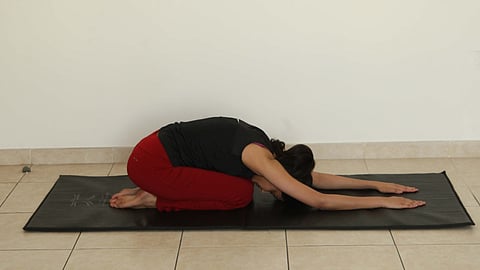Yoga for relief from migraines
Bharat Thakur guides you through the practices of this ancient Indian discipline

Migraine is a neurological disorder that can cause intense throbbing in an area of the head and is commonly accompanied by nausea, vomiting and extreme sensitivity to light and sound. This pain can last anywhere between 4 to 72 hours. The cause for migraines is not known but lifestyle and hormonal changes have been identified as triggers.
How yoga helps
Stress, irregular sleep cycles and digital eye strain are commonly known to cause migraines. Regular exercise along with conventional care has been found to be helpful in reducing, if not curing, migraines. It is interesting to note that some complain aerobic exercise can be a trigger (reason is unknown) and hence avoid exercise. Slower movements or static postures in yoga done with mindfulness followed by relaxation techniques have proven to be more beneficial than pure aerobic exercise.
Regular practice of yoga helps in balancing the autonomic nervous system through enhanced activation of the parasympathetic drive (rest and digest response). Hormonal balance is restored as stress hormones, such as cortisol, decrease and there is an increase in endorphins. So, those suffering from migraines have been known to sleep better, with decreased levels of anxiety. Sleep is also a pain relieving factor during an attack.
Tips and techniques
- Identify the triggers.
- Do not skip meals.
- Get sufficient sleep every night.
- Practice yoga regularly. Include the specific postures listed in practice of the week.
- Avoid eye strain.
Reducing eye strain
Palming: Sit quietly and close the eyes. Warm the palms by rubbing your hands together vigorously. Place them gently over the eyelids without undue pressure. Feel the warmth and energy transmitted and the eye muscles relaxing. Remain in this position until the heat from the hands has been absorbed by the eyes. Lower the hands, keeping the eyes closed. Repeat the procedure at least three times.
Make sure the palms and not the fingers cover the eyes.
Palming also stimulates the circulation of the aqueous humour — the liquid that runs between the cornea and the lens of the eye — aiding the correction of defective vision.
Blinking: There remains state of habitual tension in the eyes with constant glaring at the screen. This exercise encourages the blinking reflex to become spontaneous, inducing relaxation of the eye muscles.
Sit with eyes open. Blink 10 times quickly. Close the eyes and relax for 20 seconds. Repeat five times.
Another useful practice is to splash cold water into the eyes at frequent intervals.
Practice of the week
Practice joint rotation (wrist, shoulder and neck) along with the following postures for relief from migraine.
Dwikonasana
Gomukhasana
Kandharasna
Shashankasana
Next week: Yoga techniques to relieve eye fatigue
Sign up for the Daily Briefing
Get the latest news and updates straight to your inbox



